A Japanese version of Nextstrain's report that analyzes the epidemic situation of the new coronavirus based on gene sequence data appears

Based on `` gene sequence data of virus collected from patients '' provided by research institutions around the world, the situation of spread of virus is drawn using a world map and
The latest # COVID19 # SARSCoV2 # HCoV19 status report is now available in Japanese. This week we have broken down the data by region. Thanks to TakeshiSato, @tommy_nezy and @fengjun_zhang for the translation. https://t.co/E0gXp9vVrO
— Nextstrain (@nextstrain) March 29, 2020
Latest Situation Report The Is Now Available In Japanese. Pic.Twitter.Com/fWppSk4PE9
According to Trevor Bedford, a co-founder of Nextstrain and a computational biologist working at the Fred Hutchinson Cancer Research Center, Nextstrain provided more than 2000 types of new coronavirus gene sequence data at the time of writing. According to National Geographic , analyzing them can help them find exactly where the virus came from.
According to Bedford, when the Ebola outbreak occurred in West Africa in 2014, it took a year to collect the virus samples, identify the nucleotide sequence of the genome, and release the data. However, many laboratories are now providing samples, so it is possible to perform the same process in only 2 to 7 days, and the effect of Nextstrain's published status report in real time It is designed to be used for outbreak prevention.
The Japanese version of the status report of the new coronavirus released by Nextstrain is as follows. The following is the Japanese version of the report released on March 27, 2020, which is the latest version at the time of article creation , but the Japanese version report is also released on March 20 .
Nextstrain / narratives / ncov / sit-rep / ja / 2020-03-27
https://nextstrain.org/narratives/ncov/sit-rep/ja/2020-03-27

Mr. Bedford, who responded to the National Geographic interview, said that he analyzed 2000 kinds of gene sequence data, but a report on March 27 `` analyzed the genome of 1495 species that are publicly shared '' It is written. These are mutations of the new coronavirus, and the path of infection can be identified by following the pathway. According to Nextstrain, we are analyzing the gene sequence data of viruses collected in 48 countries on 6 continents. Only made it possible. '
The following is a visual representation of the number of new coronavirus sample data provided by each country on a world map. Nextstrain says that there is little data from the Southern Hemisphere, saying that 'the new coronavirus is not yet prevalent in the Southern Hemisphere' and 'Less available data'. The data provided by Japan is also small.

The following shows the gene sequence data of the new coronavirus provided from Europe in the phylogenetic tree (left) and map (right). In the phylogenetic tree, each circle represents a mutated virus, the horizontal axis shows the degree of difference (time or genetic difference) in the virus genome, and the vertical axis does not.
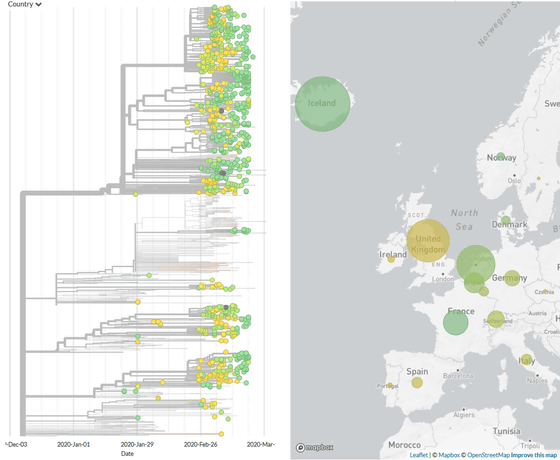
The phylogenetic tree shows the genomic samples of viruses collected in Europe in different colors by country. It is worth noting that there are some small clusters by country, and the samples from different countries are mixed together. 'This suggests that there has been a sustained spread across borders in Europe in the last three to five weeks,' says Nextstrain.
The spread pattern of infection in the United States is very complex. In Connecticut, for example, the latest samples are often spread from Washington, but mixed from multiple clusters at the same time. `` More data is needed to draw definitive conclusions, but nextstrain suggests that infection is spreading far away in the United States '' `` Diffusion occurring in the United States The pattern emphasizes that the currently available data is much more complex than it shows, with additional data to understand how the spread of infections is occurring in the United States. It helps. '
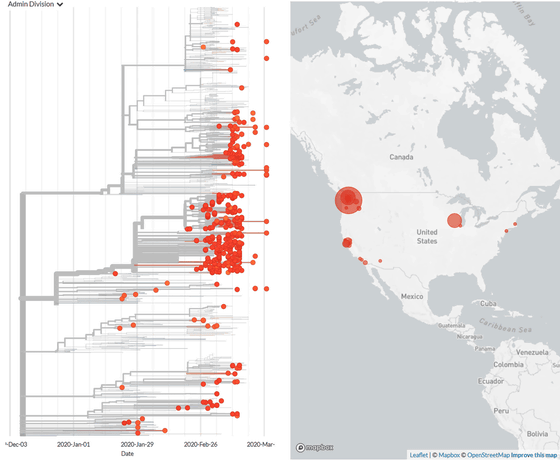
Washington has at least two distinct local infection clusters, two of which have different origins. One is from China and the other is from Europe.
In Latin America, sample data for the new coronavirus is not very large. Most cases in Latin America are samples taken from travelers. As can be seen from the colorful phylogenetic tree, travelers from various countries have developed a new type of coronavirus infection in Latin America. In addition, it seems that cases not related to travelers are starting to be reported in Latin America, but there are few samples and it is not yet at the stage where detailed status can be reported.
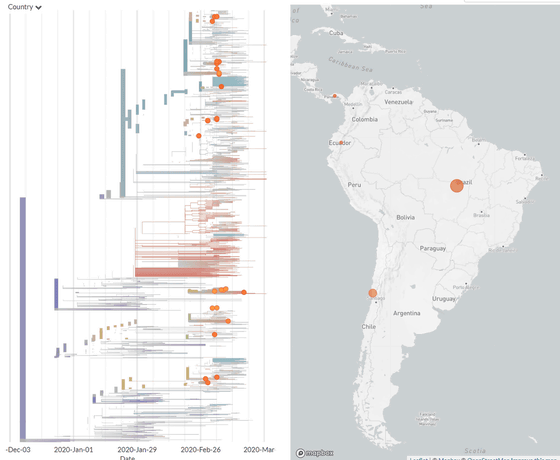
In Asian cases, a virus sample from Iran was not collected at the time of writing. However, it seems that there is gene sequence data collected from cases reported to travel to Iran, so it is possible to group virus gene sequences collected from cases that have a history of traveling to Iran. This suggests that many Iran cases are based on a single transmission of the virus.
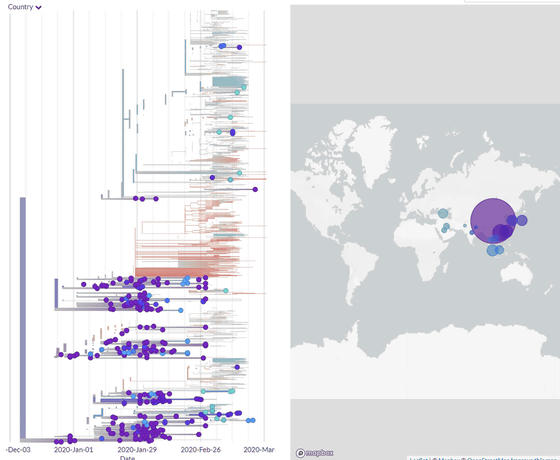
In Africa, a new variant of the new coronavirus has been discovered in Kinshasa, the capital of the Republic of the Congo, suggesting that it has followed a complex transmission pathway.
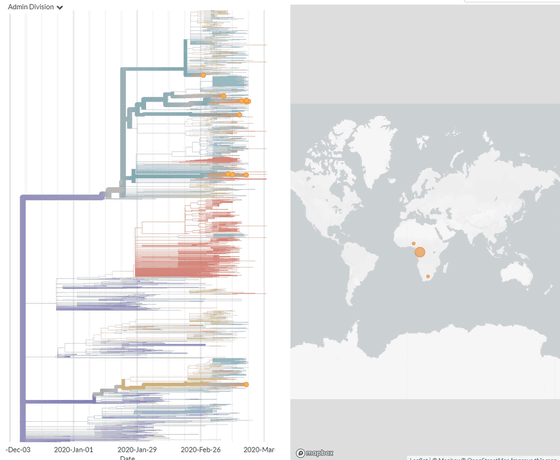
In the case of Oceania, the new coronavirus has spread locally in Australia's New South Wales, and it is possible that the virus had spread at the latest by the end of February 2020.
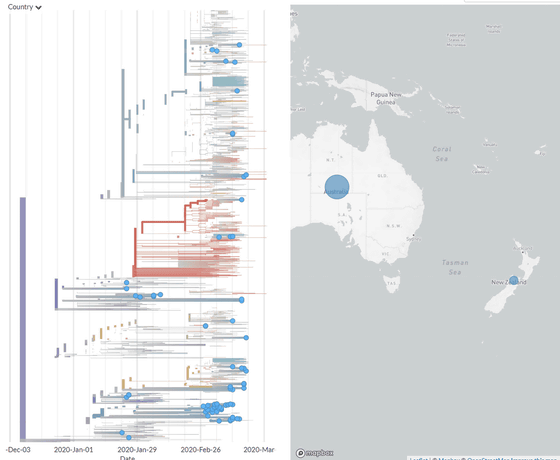
Nextstrain will be able to do the following: 'make inspections wider and free,' 'make more powerful social distance measures,' 'fund extensive contact tracking work,' ' Financially assisting those affected by social distance measures. ' Individuals should also be aware that 'populations that are susceptible to infection should strictly enforce social separation' and 'even if they are not vulnerable, Recognize the potential for vulnerability and follow practices such as movement restrictions to protect others; 'If you feel unwell, stay at home as much as possible and implement voluntary quarantine.' If you get sick, allow yourself to wait at home. '
In addition, if the data provision from Japan further increases, it will be possible to more accurately grasp the current situation and make future forecasts. In addition, visualizing the route of transmission of the new coronavirus in the phylogenetic tree should provide a measure for countermeasures.
Related Posts:
in Science, Posted by logu_ii







